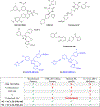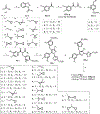Pyrazole-Based Lactate Dehydrogenase Inhibitors with Optimized Cell Activity and Pharmacokinetic Properties
- PMID: 32902275
- PMCID: PMC7830743
- DOI: 10.1021/acs.jmedchem.0c00916
Pyrazole-Based Lactate Dehydrogenase Inhibitors with Optimized Cell Activity and Pharmacokinetic Properties
Abstract
Lactate dehydrogenase (LDH) catalyzes the conversion of pyruvate to lactate, with concomitant oxidation of reduced nicotinamide adenine dinucleotide as the final step in the glycolytic pathway. Glycolysis plays an important role in the metabolic plasticity of cancer cells and has long been recognized as a potential therapeutic target. Thus, potent, selective inhibitors of LDH represent an attractive therapeutic approach. However, to date, pharmacological agents have failed to achieve significant target engagement in vivo, possibly because the protein is present in cells at very high concentrations. We report herein a lead optimization campaign focused on a pyrazole-based series of compounds, using structure-based design concepts, coupled with optimization of cellular potency, in vitro drug-target residence times, and in vivo PK properties, to identify first-in-class inhibitors that demonstrate LDH inhibition in vivo. The lead compounds, named NCATS-SM1440 (43) and NCATS-SM1441 (52), possess desirable attributes for further studying the effect of in vivo LDH inhibition.
Conflict of interest statement
The authors declare no competing financial interest.
All animal studies included as part of this manuscript were performed in accordance with institutional guidelines as defined by the Institutional Animal Care and Use Committee (IACUC).
Figures








Similar articles
-
Discovery and Optimization of Potent, Cell-Active Pyrazole-Based Inhibitors of Lactate Dehydrogenase (LDH).J Med Chem. 2017 Nov 22;60(22):9184-9204. doi: 10.1021/acs.jmedchem.7b00941. Epub 2017 Nov 9. J Med Chem. 2017. PMID: 29120638 Free PMC article.
-
Targeting Glycolysis through Inhibition of Lactate Dehydrogenase Impairs Tumor Growth in Preclinical Models of Ewing Sarcoma.Cancer Res. 2019 Oct 1;79(19):5060-5073. doi: 10.1158/0008-5472.CAN-19-0217. Epub 2019 Aug 20. Cancer Res. 2019. PMID: 31431459 Free PMC article.
-
Fragment growing and linking lead to novel nanomolar lactate dehydrogenase inhibitors.J Med Chem. 2013 Feb 14;56(3):1023-40. doi: 10.1021/jm3014844. Epub 2013 Jan 9. J Med Chem. 2013. PMID: 23302067
-
Recent Update on Human Lactate Dehydrogenase Enzyme 5 (hLDH5) Inhibitors: A Promising Approach for Cancer Chemotherapy.J Med Chem. 2016 Jan 28;59(2):487-96. doi: 10.1021/acs.jmedchem.5b00168. Epub 2015 Sep 4. J Med Chem. 2016. PMID: 26340601 Review.
-
A patent review of lactate dehydrogenase inhibitors (2014-present).Expert Opin Ther Pat. 2024 Nov;34(11):1121-1135. doi: 10.1080/13543776.2024.2412575. Epub 2024 Oct 6. Expert Opin Ther Pat. 2024. PMID: 39358962 Review.
Cited by
-
Synthesis of Ethyl Pyrimidine-Quinolincarboxylates Selected from Virtual Screening as Enhanced Lactate Dehydrogenase (LDH) Inhibitors.Int J Mol Sci. 2024 Sep 9;25(17):9744. doi: 10.3390/ijms25179744. Int J Mol Sci. 2024. PMID: 39273691 Free PMC article.
-
Targeting mitochondrial metabolism for precision medicine in cancer.Cell Death Differ. 2022 Jul;29(7):1304-1317. doi: 10.1038/s41418-022-01022-y. Epub 2022 Jul 13. Cell Death Differ. 2022. PMID: 35831624 Free PMC article. Review.
-
Small Molecule-Based Enzyme Inhibitors in the Treatment of Primary Hyperoxalurias.J Pers Med. 2021 Jan 27;11(2):74. doi: 10.3390/jpm11020074. J Pers Med. 2021. PMID: 33513899 Free PMC article. Review.
-
Synthesis and hLDH Inhibitory Activity of Analogues to Natural Products with 2,8-Dioxabicyclo[3.3.1]nonane Scaffold.Int J Mol Sci. 2023 Jun 8;24(12):9925. doi: 10.3390/ijms24129925. Int J Mol Sci. 2023. PMID: 37373073 Free PMC article.
-
Glucose metabolism and its direct action in cancer and immune regulation: opportunities and challenges for metabolic targeting.J Biomed Sci. 2025 Jul 29;32(1):71. doi: 10.1186/s12929-025-01167-1. J Biomed Sci. 2025. PMID: 40734168 Free PMC article. Review.
References
-
- Warburg O; Posener K; Negelein E Ueber den stoffwechsel der tumoren. Biochem. Z 1924, 152, 319–344.
-
- Rong Y; Wu W; Ni X; Kuang T; Jin D; Wang D; Lou W Lactate dehydrogenase A is overexpressed in pancreatic cancer and promotes the growth of pancreatic cancer cells. Tumor Biol. 2013, 34, 1523–1530. - PubMed
Publication types
MeSH terms
Substances
Grants and funding
LinkOut - more resources
Full Text Sources
Chemical Information

